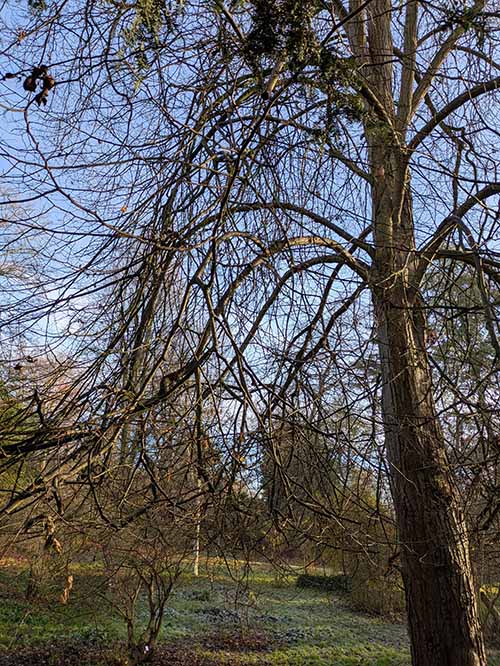#130 CAUCASIAN LIME
Tilia × euchlora

Planted: 1915
This tree is near the centre of the Central Path, on the north side.
| Distribution: | Thought to be a hybrid of Tilia cordata and Tilia dasystyla. The two species are native to the Caucasus, but they do not share the same habitats. The tree is sterile, and no similar hybrids are found in the wild. |
| Planting Date: | 1915, purchased from John St Barbe Baker, The Firs, West End, Southampton, Hampshire |
| Growth Habit: | Has a pyramidal shape with dense crown, the branches are somewhat pendulous. |
| Bark: | The young bark is greyish-brown and smooth, but fissures appear with age. |
| Leaf: | Leaves are cordate and 5 to 9 cm long and 5 to 7.5 cm wide. Heart shaped, upper surface glossy, dark green, and undersides paler with tufts of hair along the veins. The autumn foliage is yellow. |
| Flowers: | Very fragrant, white to pale yellow with a cluster of 3 to 7 flowers. |
| Fruit: | Grayish-brown hairy nutlet – sterile |
| Toxicity: | Not known |
| Potential tree size | 20m high and 15m wide |
| Uses: | Planted singularly or in groups as an ornamental shade for the lawn or as a street tree. A clean Lime being free of aphids. The rich sugary nectar of the flowers is attractive to bees and butterflies. |
| Plant Hunter: | The German botanist, Karl Koch, described the tree in 1866. His description is based on a young specimen that was found in Berlin. It was thought that the tree originated from a seed collected in Crimea, Ukraine. Since the tree is sterile, the trees in cultivation may be the result of a single clone. Alternative common name is: Crimean Lime (Linden in US) |
| Introduction Date: | circa 1860 |
| Anecdotes and Comments: | The genus name ‘Tilia‘ is Latin for Linden or Lime Tree. It is derived from the Greek word ‘ptelea‘ or ‘Elm tree’ and ‘tillai ‘or ‘Black Poplar.’ The translation meaning broad or perhaps broad-leaved. The species name, ‘echlora‘, originated from the Greek words ‘eu ‘meaning good and ‘chloros‘ meaning green – the tree’s foliage. |